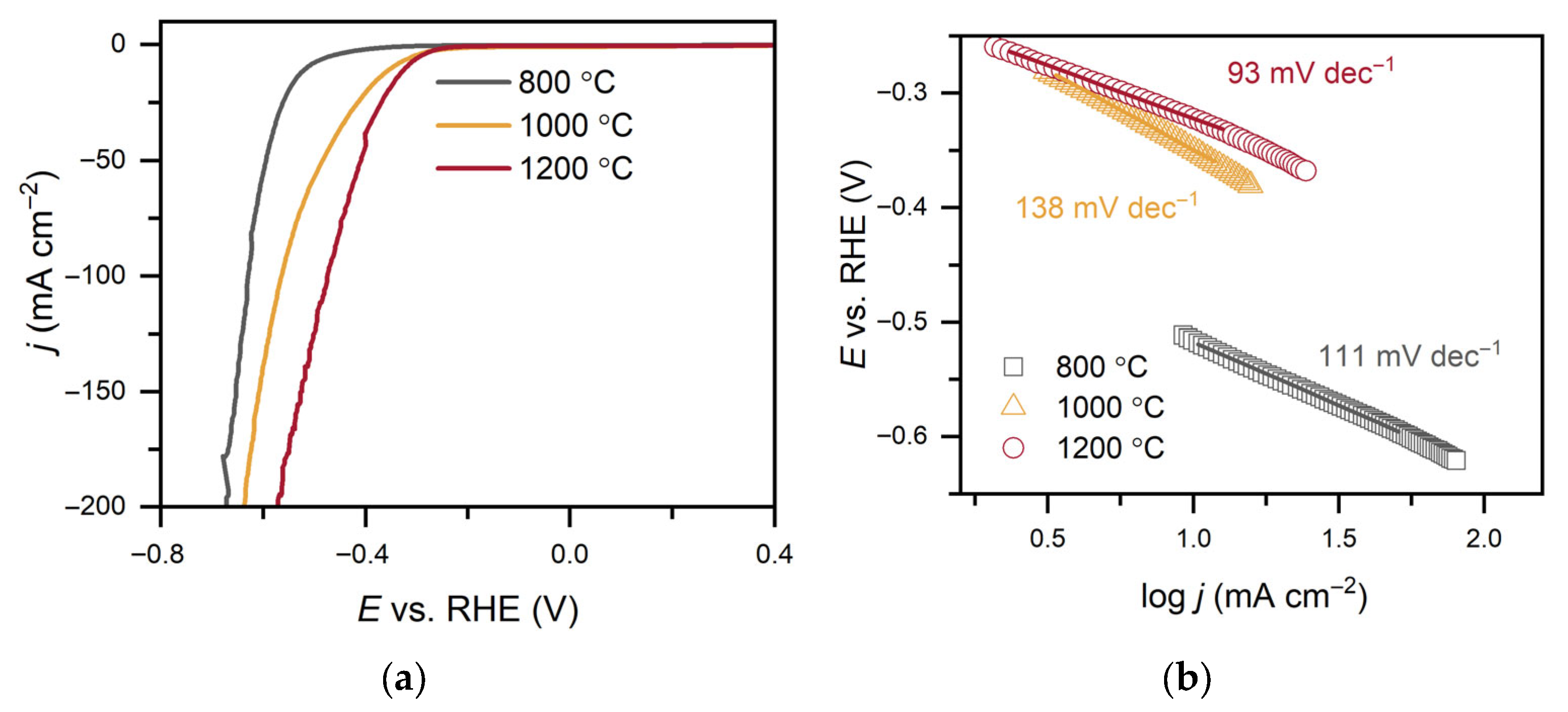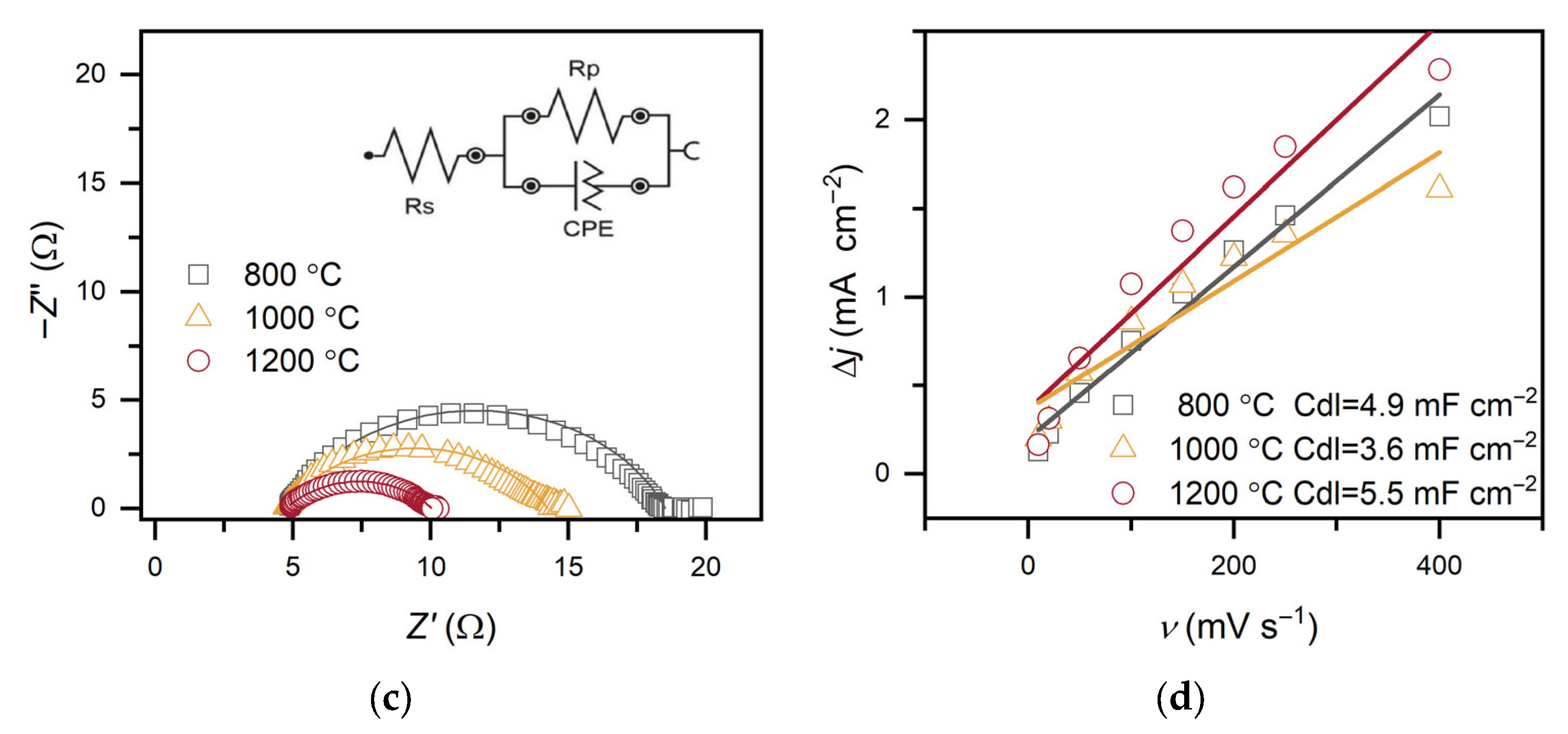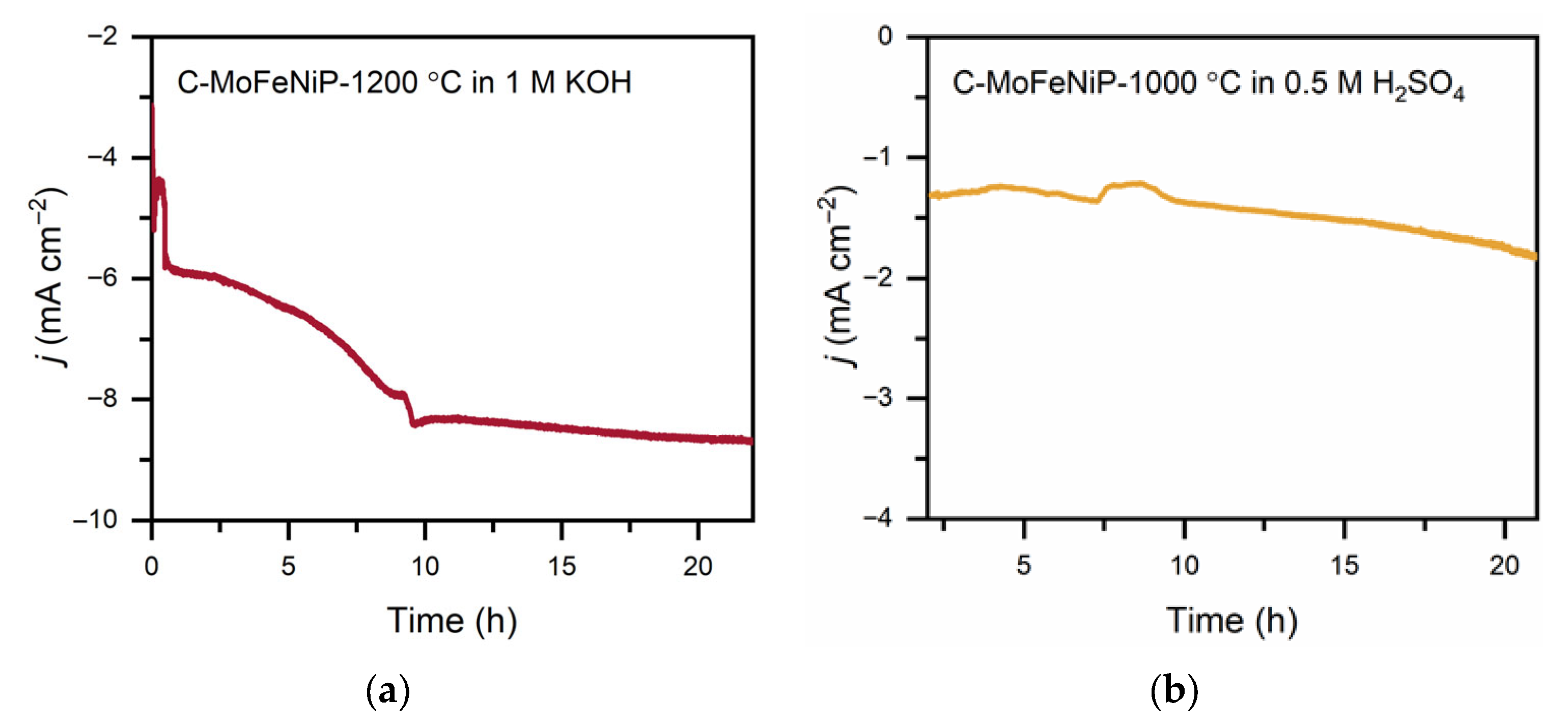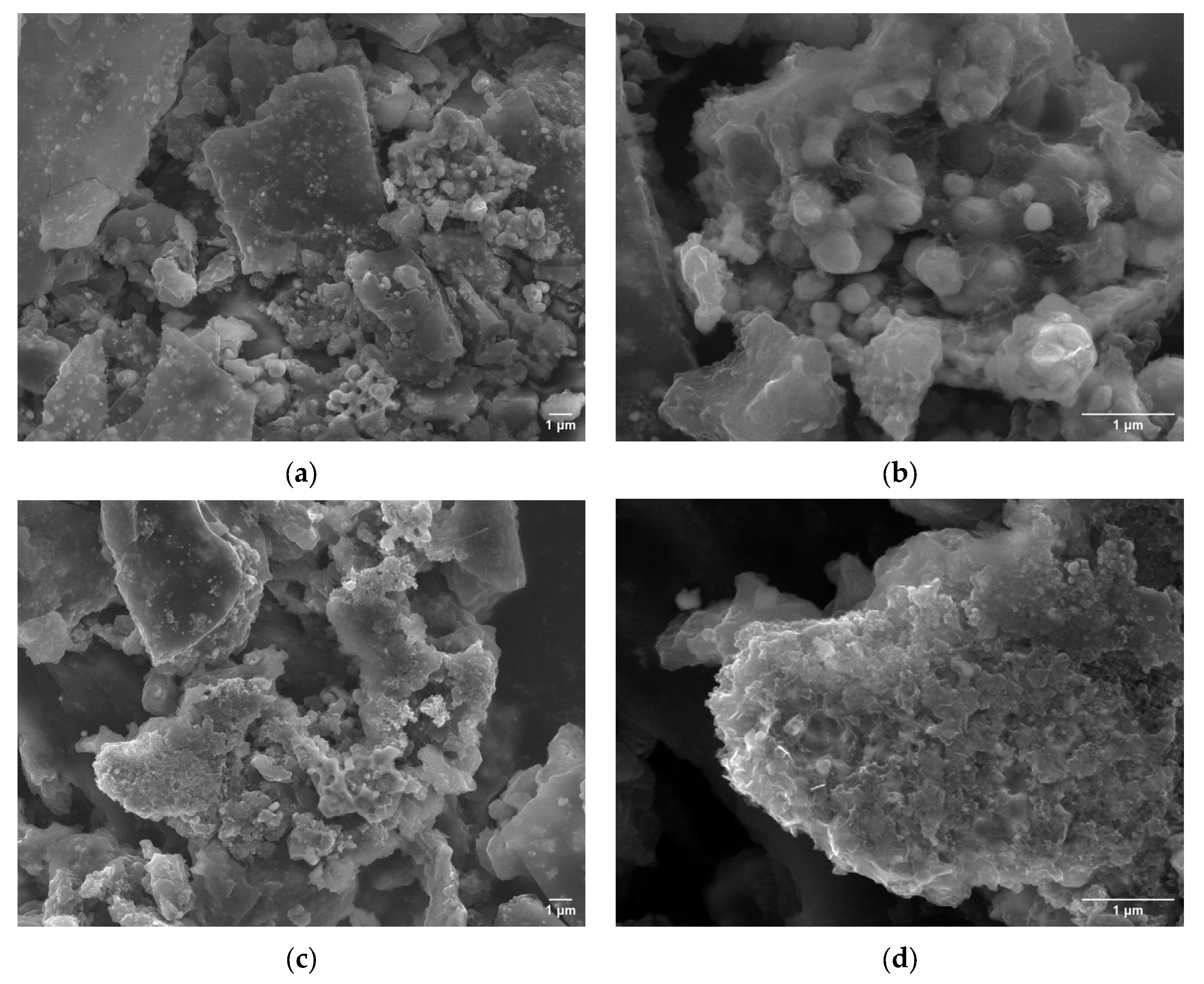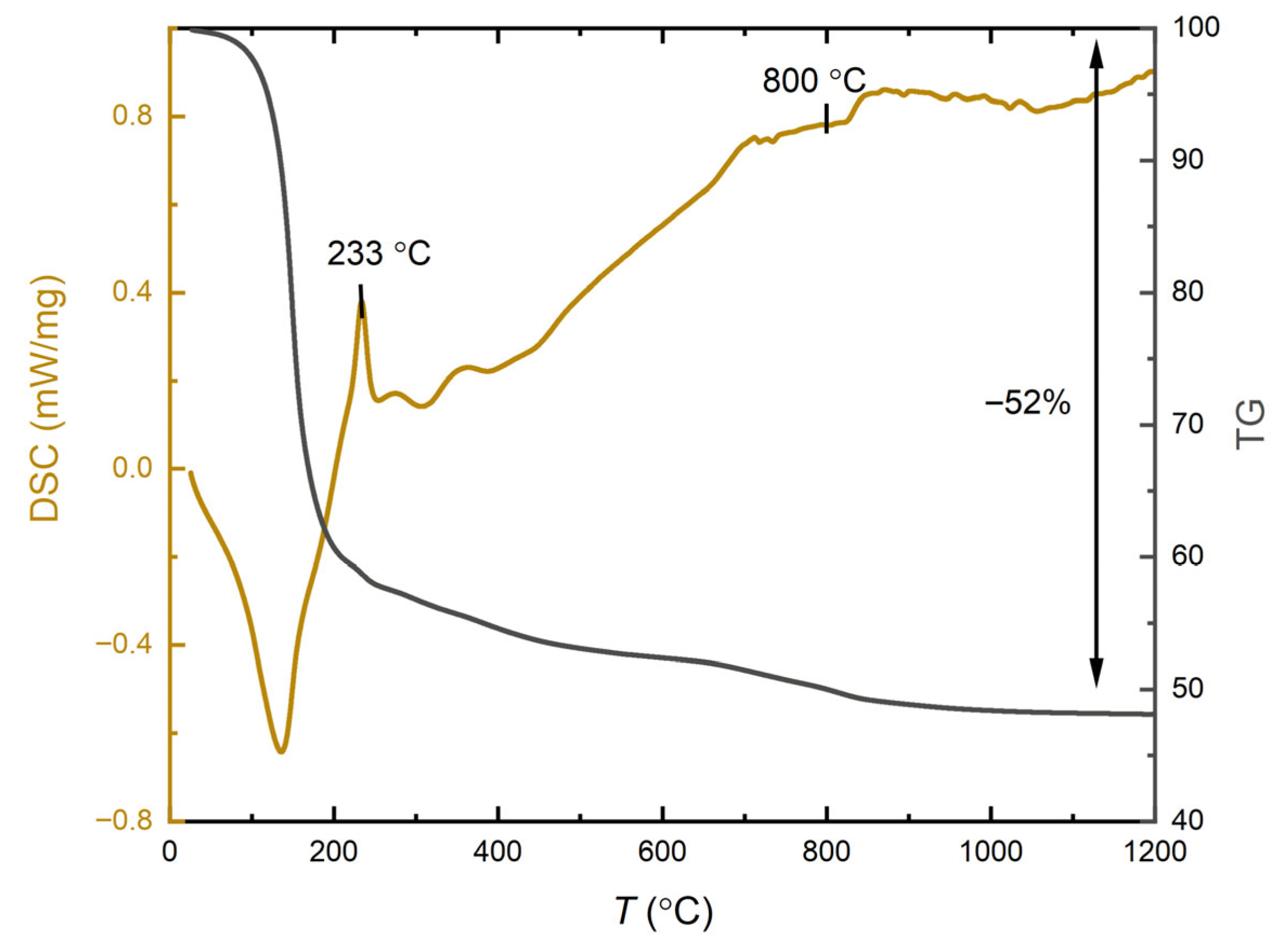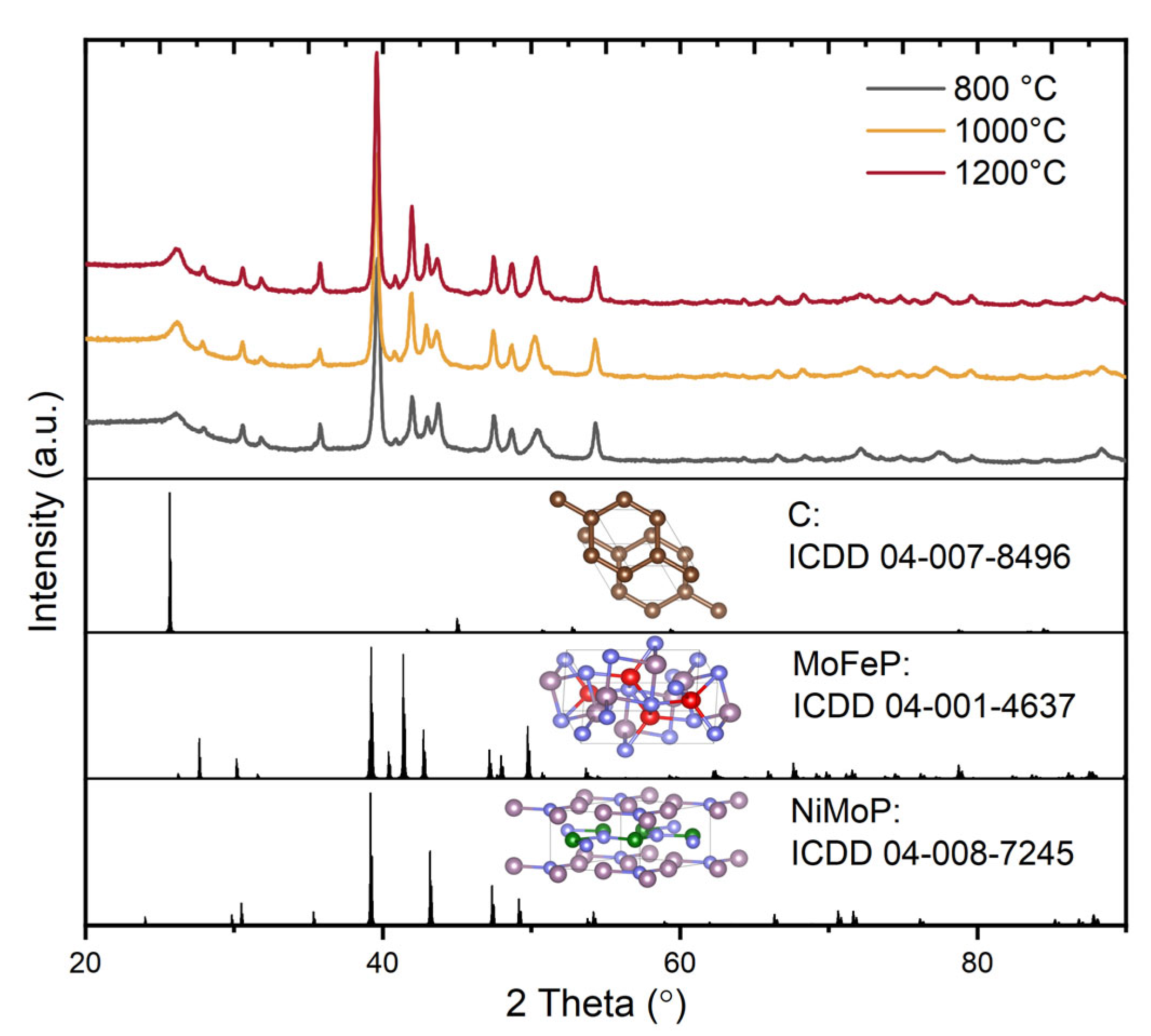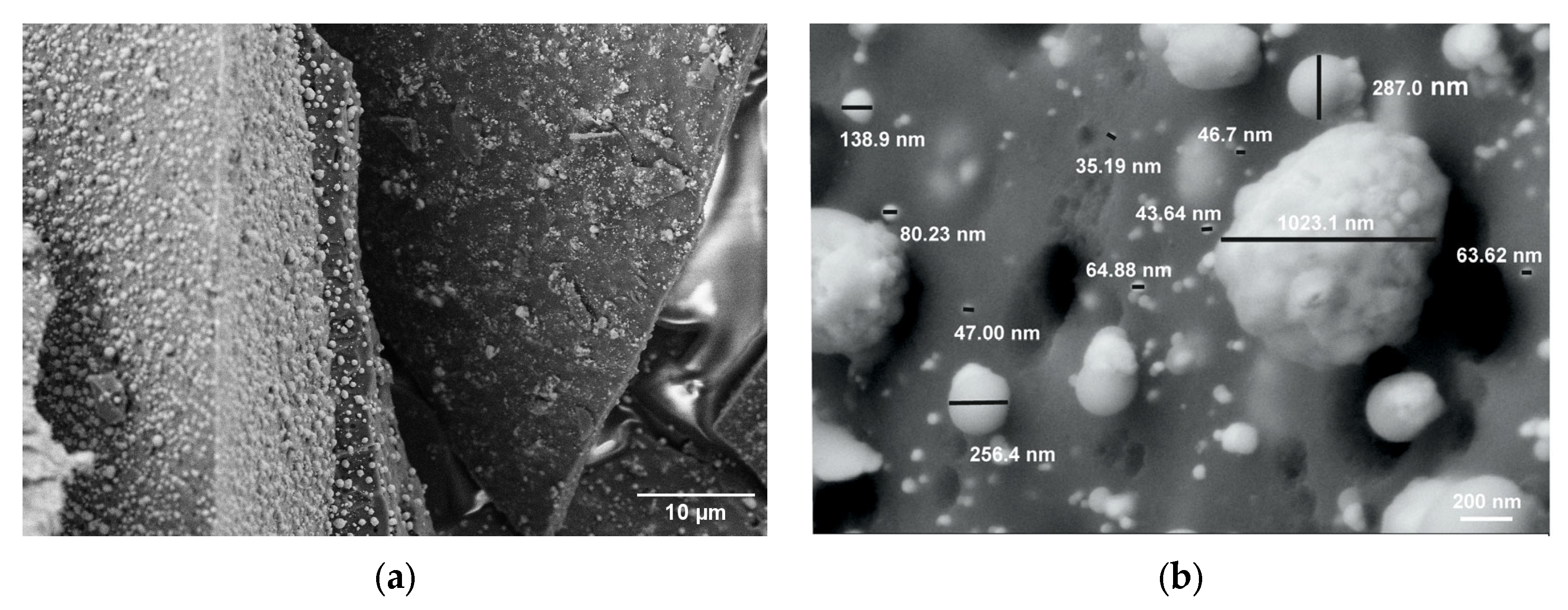3.1. Structural and Morphological Characterization
The most critical step in the preparation of MoFeNiP catalysts was found to be the heat treatment process. The heating program for the polymeric precursor sample was determined based on differential scanning calorimetry (DSC) and thermogravimetric analyses (TGA).
Figure 1 shows the TG and DSC profiles of the polymeric sample, recorded under an argon atmosphere from 0 °C to 1200 °C, to observe the thermal behavior and the formation of the oxide phase of the future trimetallic MoFeNiP phase.
From a thermochemical perspective, the degradation of the precursor gel comprising PAN/H
3PO
4 and the metal chlorides NiCl
2·6H
2O, FeCl
3·9H
2O, and MoCl
5 (hydrolize) can be divided into three main stages: (i) Stabilization (pre-oxidation) of the polymer. This occurs between 23 °C and 233 °C. In this stage, a sharp exothermic peak at 233 °C is observed, which corresponds to oxidation reactions and the combustion of the polymer matrix [
6,
20]. At this stage, the loss of water from the ceramic precursors is also taking place. The process involves the simultaneous hydrolysis and decomposition of metal chloride precursors within a hydrophobic, non-water-soluble PAN-based polymer matrix. Critically, the polymer’s structural integrity prevents the typical dissolution and collapse of the chloride salts in their own crystallization water, allowing the formed gel to retain its desired structure. Specifically, the thermal decomposition of FeCl
3·9H
2O and the rapid hydrolysis of MoCl
5 both release HCl gas, forming species like Fe(OH)
2Cl and molybdenum oxychlorides, respectively. This evolved HCl, along with water and other gases originating from the PAN stabilization, becomes entrapped within the matrix. These gaseous byproducts act as effective porogens, creating a robust micro/macroporous architecture in the final material. This phase is coupled with the thermal stabilization of the PAN polymer, initiating molecular cyclization and aromatization, simultaneously achieving the essential incorporation of phosphorus into the nascent carbonaceous network [
18]. This stage is responsible for the major weight loss observed during the overall thermal degradation process. (ii) Decomposition of metal chlorides and their previously formed crystallohydrates decomposition products. Occurring between 233 °C and 600 °C, this stage involves a slow exothermic process, visible as a gradual decline in the TG curve. It includes the stepwise dehydration of crystalline water from NiCl
2·6H
2O and Fe(OH)
2Cl and possible FeCl
3·9H
2O leftovers, followed by further dehydrochlorination and dechlorination reactions [
21]. (iii) Final decomposition and phase formation. From 600 °C to 800 °C the final decomposition of the dehydrated metal chlorides and oxychlorides occurs, releasing Cl
2 gas. Beyond this temperature, only a negligible weight loss is detected also mostly originating from PAN final carbonisation. The remaining gradual decrease in mass is attributed to slow gradual dechlorination of metal chlorides leftovers and releasing of the entrapped gases, leading to the formation of MoFeNi(PO
4)
2 within the graphitic carbon substrate network. This final product represents approximately 48 wt% of the original starting materials. Based on the results described above, three different temperatures 800 °C, 1000 °C, and 1200 °C were tested for the preparation of phosphate intermediates containing all three metals. Drawing from our previous experience, these intermediates were subsequently subjected to a reduction in a Ar/H
2 atmosphere at 780 °C to form the final multimetal phosphides [
19].
The structural analysis of the final MoFeNiP powdered electrocatalysts, sintered at three different temperatures, is presented in
Figure 2.
All samples exhibited nearly identical X-ray diffraction (XRD) patterns, indicating the successful incorporation of all metallic elements into an orthorhombic and hexagonal crystal structure supported on a carbon matrix. According to database references, two distinct crystalline phases were identified: MoFeP, crystallizing in the orthorhombic system with space group Pnma (ICDD 04-001-4637; a = 5.922 Å, b = 3.663 Å, c = 6.790 Å), characterized by prominent reflections at 2θ ≈ 39.6° (112), 42.0° (211), 43.7° (103), and 50.4° (020) and NiMoP, crystallizing in the hexagonal system with space group P62m (ICDD 04-008-7245; a = b = 5.861 Å, c = 3.704 Å), with the most intense diffraction peaks observed at 2θ ≈ 39.2° (111), 43.1° (201), and 47.4° (210). In addition, graphitic carbon with a hexagonal structure belongs to space group P63/mmc (ICDD 04-007-8496; a = b = 2.430 Å, c = 6.940 Å). The most intense peaks corresponding to this phase were observed at 2θ ≈ 25.6° and a weaker reflection at 45°, attributed to the (002) and (101) planes, respectively. In summary, although the fundamental crystal lattice remains unchanged, increasing the sintering temperature leads to changes in peak intensities in the 2θ range of 40–43°, along with more pronounced diffraction signals. This variation in the C-MoFeNiP pattern can be attributed to improved crystallization at higher temperatures.
The structural nature and disorder level of the carbon component were investigated using Raman spectroscopy (
Figure 3).
The Raman spectra exhibit two characteristic bands indicative of graphitic carbon (
Figure 3): the G band at 1586 cm
−1, corresponding to the in-plane stretching vibration of sp
2-hybridized C–C bonds in an ordered graphitic lattice, and the D band at 1340 cm
−1, which arises from the breathing modes of sp
2 carbon rings and is activated by structural disorder or defects within the carbon matrix. The intensity ratio ID/IG, which reflects the degree of disorder and defect density in the graphitic structure, was found to be approximately 1 across all samples, with only minor variations observed. This consistent ratio suggests the formation of a similar hexagonal graphitic carbon phase in all samples, independent of the sintering temperature applied. Furthermore, the ID/IG ratio close to 1 indicates a high degree of structural disorder, characterized by a significant presence of defects, vacancies, grain boundaries, edge sites, and possible interlayer misalignment within the graphitic domains. This disorder may also point to the presence of partially reduced graphene-like structures, or alternatively, indicate that the sintering temperature was insufficient to promote full graphitization into a more ordered carbon structure. Notably, such disordered carbon materials with abundant edge sites and structural defects are advantageous for electrocatalytic applications, as these features contribute to an increased number of electrochemically active sites, thereby enhancing catalytic performance.
The morphology and elemental distribution of all synthesized samples were examined using SEM coupled with EDX analysis (
Figure 4). The SEM images reveal a uniform dispersion of particles both within and on the surface of the carbon matrix, exhibiting a broad particle size distribution ranging from 30 nm to 1 μm (
Figure 4a,b).
This size range remained relatively consistent across all sintering temperatures, indicating good thermal stability of the particle morphology. A slight deviation was observed in the sample sintered at 800 °C (C-MoFeNiP-800), where a reduced number of particles was detected on the carbon surface, suggesting possible changes in particle matrix interactions at elevated temperatures. Notably, increasing the sintering temperature led to a subtle morphological evolution from predominantly spherical to slightly ellipsoidal particle shapes (
Figure 5).
This transformation is attributed to enhanced atomic mobility and anisotropic growth mechanisms at higher temperatures phenomena that are well-established in nanomaterial systems. Furthermore, elevated thermal energy drives the improved interdiffusion and mixing of metallic species within the phosphide phase, resulting in the development of more homogeneous and structurally integrated metal phosphide domains [
22].
EDX mapping analysis confirmed the preferential localization of metal elements (Mo, Ni, and Fe) along with phosphorus at the positions corresponding to the observed particles in the SEM overview. This spatial correlation indicates the successful incorporation of Mo, Ni, and Fe into the phosphide phase. Furthermore, the carbon matrix was identified as a supportive framework for the formation and stabilization of the trimetallic phosphide micro/nanoparticles, serving as both a dispersing medium and a structural support.
Table 1 summarizes the elemental composition of the prepared sample.
A somewhat lower content of Mo is evident, given the molar ratio of the input salts which was equimolar. This observation may be attributed to the intrinsic properties of molybdenum, which has a significantly higher melting point and lower diffusivity compared to Fe and Ni. At the given sintering temperatures, these factors can hinder the efficient diffusion and incorporation of Mo into the phosphide structure. Additionally, if Mo is more deeply embedded within the carbon matrix, the carbon may attenuate or absorb part of the emitted X-rays during EDX analysis, leading to an underestimation of Mo content. This effect is particularly relevant when analyzing heavier elements, such as Mo, in a light-element matrix like carbon.
3.2. Electrochemical Characterization
The electrocatalytic properties of C-MoFeNiP materials synthesized at different pyrolysis temperatures were systematically investigated for HER in both alkaline (
Figure 6 and
Table 2) and acidic (
Figure 7 and
Table 3) media. In alkaline conditions, catalytic performance improved with increasing pyrolysis temperature, with C-MoFeNiP-1200 exhibiting the highest HER activity (η
10 = 321 mV). In contrast, in acidic media, optimal performance was observed for C-MoFeNiP-1000 (η
10 = 228 mV). The difference in optimal catalysts between alkaline and acidic environments is consistent with previous reports, but its mechanistic origin remains not fully understood [
11].
Further electrochemical characterization revealed that the best-performing catalysts also exhibited the most favorable kinetic parameters, including the lowest Tafel slopes and highest charge transfer coefficient (α), indicating faster reaction kinetics, as well as the smallest charge transfer resistance (Rct), reflecting more efficient charge transfer at the catalyst–electrolyte interface.
A closer examination of the Tafel slopes provides additional mechanistic insight. Depending on the synthesis temperature, the Tafel slopes decreased with increasing pyrolysis temperature from around 120 mV dec
−1 to 93 mV dec
−1 (C-MoFeNiP-1200 in alkaline media) and 98 mV dec
−1 (C-MoFeNiP-1000 in acid), indicating that the appropriate choice of temperature can improve the Volmer step and thereby enhance overall HER kinetics. For better clarification, the individual steps of the mechanism are provided below. In alkaline media it can be assumed that such a mechanism exists where the OH
− is produced to form oxide/hydroxide [
19]:
HER in alkaline electrolyte:
During the Volmer step, the generation of OH− ions near the electrode surface locally increases the pH, promoting surface hydroxylation or oxidation. As a result, a thin (oxy)hydroxide layer (e.g., Ni(OH)2, FeOOH, or MoO) may form, while part of the phosphide phase can dissolve into the electrolyte. This surface reconstruction can lead to minor activation effects or stabilization under continuous operation. Consequently, these processes explain the distinct stability behavior observed in 1 M KOH compared with acidic media, where no such hydroxide formation occurs and the catalyst typically requires a longer time to reach a steady state during HER operation.
EIS further elucidated charge-transfer behavior. In both alkaline media and acidic media, Nyquist plots fitted with an equivalent circuit comprising solution resistance (Rs), Rct, and a constant phase element (CPE) revealed similar Rs values (between 4–5 Ω) for all catalysts.
Figure 6.
(a) LSV curves of C-MoFeNiP catalysts treated at different temperatures, measured in 1 M KOH (scan rate of 1 mV s−1 and rotation speed of 500 rpm); (b) corresponding Tafel plots; (c) Nyquist plots from EIS recorded in 1 M KOH at −485 mV with the inset showing the equivalent circuit; (d) capacitance current density vs. scan rate with Cdl values.
Figure 6.
(a) LSV curves of C-MoFeNiP catalysts treated at different temperatures, measured in 1 M KOH (scan rate of 1 mV s−1 and rotation speed of 500 rpm); (b) corresponding Tafel plots; (c) Nyquist plots from EIS recorded in 1 M KOH at −485 mV with the inset showing the equivalent circuit; (d) capacitance current density vs. scan rate with Cdl values.
Figure 7.
(a) LSV curves of C-MoFeNiP catalysts treated at different temperatures, measured in 0.5 M H2SO4 (scan rate of 1 mV s−1 and rotation speed of at 1000 rpm); (b) corresponding Tafel plots; (c) Nyquist plots from EIS recorded in 0.5 M H2SO4 at −589 mV; (d) capacitance current density vs. scan rate with Cdl values.
Figure 7.
(a) LSV curves of C-MoFeNiP catalysts treated at different temperatures, measured in 0.5 M H2SO4 (scan rate of 1 mV s−1 and rotation speed of at 1000 rpm); (b) corresponding Tafel plots; (c) Nyquist plots from EIS recorded in 0.5 M H2SO4 at −589 mV; (d) capacitance current density vs. scan rate with Cdl values.
In alkaline media, Rct increased with decreasing pyrolysis temperature (5.3 Ω, 9.6 Ω, and 13.7 Ω for C-MoFeNiP-1200, -1000, and -800, respectively), indicating more efficient charge transfer for higher temperature samples, while in acidic media, Rct followed a different trend (4.5 Ω, 3.6 Ω, and 7.6 Ω for C-MoFeNiP-1200, -1000, and -800, respectively) with the lowest Rct for C-MoFeNiP-1000 correlating with its superior HER activity.
To further examine the interfacial properties, the CPE exponent (N-CPE) was compared. In contrast to the acidic media, where N-CPE values were almost identical for all investigated samples, a decrease was observed in KOH with increasing synthesis temperature. This behavior can be attributed to surface reconstruction and the formation of oxy(hydroxide) phases, as commonly reported in the literature for TMP under alkaline conditions [
19,
23].
Furthermore, capacitance analysis provided insight into the nature of active sites in C-MoFeNiP. While the C
dl, determined from non-faradaic CV measurements, showed no correlation with HER activity, the effective capacitance (C
eff), extracted from EIS measurements under faradaic conditions, demonstrated a clear correlation. This observation aligns with recent reports highlighting that C
dl often does not reflect the true number of active sites, as it includes contributions from both inactive and active regions of the catalyst [
24], while C
eff more reliably reflects the sites involved in the reaction [
25]. These results suggest that the carbon primarily serves as a conductive and stable support, while the actual HER activity originates from metallic phosphide phases [
5].
Differences in HER performance among the catalysts obtained at different pyrolysis temperatures can be attributed to structural and compositional changes. XRD and EDX analyses revealed that the increasing pyrolysis temperature promotes both improved crystallization and interdiffusion and mixing of metallic species within the phosphide phase of C-MoFeNiP (
Figure 2). Although the Raman spectra did not reveal any significant changes in the degree of disorder within the carbon matrix, the increase in temperature clearly indicates enhanced crystallinity of phosphide phases (
Figure 2) and notable alterations in particle morphology, particularly at 1200 °C (
Figure 5). These results indicate that the observed variations in HER activity of C-MoFeNiP obtained at different temperatures are mainly governed by the crystalline phase and composition of the metal phosphides.
For the stability measurements, the best-performing catalyst in each environment was selected to demonstrate durability under the respective conditions. Chronoamperometric stability tests of C-MoFeNiP-1200 in alkaline media revealed an increase in current density during the initial 10 h, followed by steady-state behavior. In acidic media, the chronoamperometric test revealed a stable current response over time, indicating good electrochemical stability of C-MoFeNiP-1000 (
Figure 8).
The post-stability EDX analysis confirmed differences between the C-MoFeNiP tested in alkaline and acidic media (
Table 1). In alkaline medium, a noticeable indecrease in the M/P ratio (M is the sum of all metals) was observed, accompanied by an increase in the oxygen content, indicating partial dissolution of P and oxidation of the surface. In contrast, under acidic conditions (H
2SO
4), the M/P ratio remained almost constant. These observations are consistent with previous reports [
23] describing similar behavior of TMP-based catalysts.
The lower current density observed in the acidic electrolyte may partly arise from the accumulation of hydrogen bubbles adhering to the electrode surface, which can block active sites and impede charge transfer, rather than from inherently lower catalytic activity. This undesirable effect can be avoided in electrolyzers that mostly operate under pressure, which allows for easier detachment of bubbles from the electrode surface. SEM analysis at lower magnification did not reveal any significant morphological changes compared to the material prior to the stability test (
Figure 9a,c), indicating overall structural integrity. However, high-resolution imaging clearly shows surface disruption in both samples. In particular, under acidic conditions, leaching of the carbon matrix was observed, leading to the exposure of embedded phosphide particles. A comparable effect was noted under alkaline conditions, where increased porosity of the carbon matrix was evident (
Figure 9b,d).
Figure 8.
Chronopotentiometric stability measurement for C-MoFeNiP for 22 h (a) at −285 mV vs. RHE in an alkaline environment, and (b) at −229 mV vs. RHE in an acidic environment.
Figure 8.
Chronopotentiometric stability measurement for C-MoFeNiP for 22 h (a) at −285 mV vs. RHE in an alkaline environment, and (b) at −229 mV vs. RHE in an acidic environment.
Figure 9.
SEM images of C-MoFeNiP after a 22 h chronoamperometry stability test: (a,b) post-test morphology in an acidic environment; (c,d) post-test morphology in an alkaline environment.
Figure 9.
SEM images of C-MoFeNiP after a 22 h chronoamperometry stability test: (a,b) post-test morphology in an acidic environment; (c,d) post-test morphology in an alkaline environment.
Overall, the combined electrochemical analyses demonstrate that the HER performance of C-MoFeNiP catalysts is strongly influenced by pyrolysis temperature, which governs the crystalline phase and composition of the metal phosphides, the kinetics of the Volmer step, and the charge-transfer properties at the catalyst-electrolyte interface.
The C-MoFeNiP electrocatalyst, being a multimetallic phosphide system, exhibits distinct electrocatalytic behavior in acidic and alkaline media due to differences in HER mechanisms, adsorption properties, and the influence of pH on active site functionality.
It has been previously reported that TMP-based catalysts exhibit different behaviors in alkaline and acidic environments during HER. In an alkaline medium, where the HER is generally the slowest step due to the water dissociation step, P can dissolve, leaving the remaining metal to transform into hydroxides and oxides [
23]. Wei et al. [
26] reported that Mo oxides formed on MoFeNiP enhance HER activity, while Zhang et al. [
23] emphasized that this increase in activity is apparent because the formed metal oxides drastically increase the ECSA, and when activity is compared by ECSA instead of geometric surface area, a decrease in activity is observed rather than an increase. To confirm the observed behavior corresponds to activation processes, phosphorus dissolution with subsequent surface oxide/hydroxide formation, or morphology changes in the carbon matrix, more detailed characterization before and after the stability test is needed to further optimize the HER performance of C–MoFeNiP in alkaline media.
Regarding the behaviour of TMP in acidic media, generally with a fast Vomer step, it has already been shown that both metal and P dissolve, but the dissolution is proportional, so the activity is maintained [
23]. However, the retention of H
2 bubbles creates a resistive barrier, which significantly reduces the activity of the catalyst. Addressing this issue will require optimizing the hydrophilic and hydrophobic properties of C-MoFeNiP to facilitate bubble release [
11].
